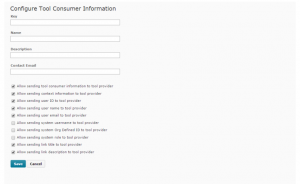So, I’ve been poking around with D2L’s badging/certificate since it was unveiled in September (and actually writing this blog post since then!) on our test instance and it’s been a fun thing actually thinking about and configuring a new tool. It’s been so long since I’ve actually spun something new up – that I had to really work the part of my brain that frankly hasn’t been worked in a long time – the “what if?” part. What really stinks is that with badging we actually don’t want to have every instructor available to create badges. That simply means controlling access to the tool via Navigation Bars (which we don’t allow our instructors to change) or creating a new role. Either way is a bunch of manual work for me.
The one big problem, and this isn’t by any means a knock against us, is that I haven’t had time to properly configure this on test in a way that makes testing easy – I’ve just been too busy working with ePortfolios and PebblePad to take the time. Thankfully there’s documents like the Assessments Administrator Guide on the Brightspace Community that help a lot when working through the user permissions (which frankly are poorly documented) and what used to be called DOME variables (now Config Variable Browser). So we’ve slowly got the technical side working and we’ve run into a huge issue that could conceivably cripple the whole damn thing. Issuing a certificate or award (or digital badge) means that we’re giving power to instructors that Registrar’s previously held very closely to themselves. So, we’ve devised a way to do this without ruffling institutional feathers – and with a way to control how the badges are used.
We really want to avoid badging as another way to give grades or learning outcomes. There is already a wealth of tools in the LMS that do this (uhhh, Grades and Competencies/Outcomes) so do not recreate what you already do and add a pretty picture to it. That is useless, and students will inevitably find badges useless in that context. More importantly, external parties will find badges useless, which if you really want badges to hold some value, then you will need external people to value them. Giving a badge that says you got an A in a course, is frankly useless (as useless as the A is in determining what a person is capable of or knows).
So as an institution we are looking at ways that we can ensure that people using badges are using them in ways that actually contribute to the student experience, by either awarding badges that have no representation elsewhere (like experiences that could make up a part of a co-curricular record) or awarding badges for skills that are not explicitly found within the core curriculum. Students already have a transcript that uses grades as a way of communication ideas about broad topics. Students should have learning outcomes that syllabi tell them are the important aspects of those courses. Don’t bother recreating the wheel – higher education already has a few that work well enough. Focus on what doesn’t get communicated already.
Our initial plan was to have training help people through this process and when they complete the training, they can then issue badges within their courses context. We’re still doing that – but with an added wrinkle. By the end of the workshop, instructors have designed at least one badge, thinking through the visual design (and sketching it out), the implications of what a digital badge means, how this badge might connect to external groups, what criteria or release condition will issue the badge and finally, how they might value badges coming into the course from other sources.
All of this on paper. Then people can have a serious thought about how it’s technically going to happen. Essentially it’s a two hour enforced planning session.
What will inevitably come up is that some forward thinking instructor will ask “what if we want to have students give each other badges?” and the answer will be “they can’t (providing that the student role is configured in a typical way that controls access to courses)”. It’s a huge gap that’s not a problem with the tool, but with the design of the LMS.




